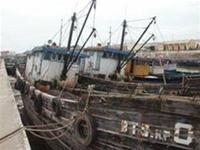The country currently has 92,000 fishing vessels in operation. According to the government-approved comprehensive plan for fisheries development until 2010, only 50,000 vessels are to be retained nationwide by that year. So, where will the more than 40,000 remaining vessels of fishermen go? Associate Professor Dr. Nguyen Chu Hoi, Director of the Institute of Economics and Fisheries Planning (Ministry of Fisheries), suggests sinking these vessels to create coral reefs. He stated:
 |
(Photo: TTO) |
– “Our idea is based on the government’s policy to reduce over 40,000 fishing vessels to protect fishery resources. Currently, our marine fishery resources are in serious imbalance. However, when proposing the solution to sink 40,000 vessels to create coral reefs, I want to emphasize that if we do not seriously implement this policy, it will be difficult to achieve the government’s goals by 2010.
* Interviewer: Why did you suggest using these reduced vessels to create coral reefs?
– Dr. Nguyen Chu Hoi: The value of coral reefs has been compared by scientists to tropical rainforests under the sea. If the value of forests upstream is precious, then coral reefs on the seabed are equally important.
If coral reefs are lost, the sea will become a “desert”, just as losing forests turns land into deserts. Coral reefs are considered the “homes” that attract various fish species for growth and development. Our seas host 2,000 species of fish. Without coral reefs, even without fishing, the fish will leave. Coral reefs not only contribute to protecting fishery resources and the marine environment but also have significant aesthetic value, making them ideal for future tourism development.
Investing in coral reefs is a sustainable and profitable long-term investment. Many countries around the world have already implemented similar measures. In Malaysia, whenever they encounter any trawlers operating at sea, they sink them. In Israel, they even use discarded tires to cultivate coral reefs, and now the country has a significant coral resource. In our country, along with various other solutions to create a living environment for coral, I believe that sinking the vessels that need to be reduced is a feasible solution.
* But sir, 40,000 fishing vessels is not a small number…
 |
| The solution of sinking 40,000 vessels to create coral reefs (Photo: TTO) |
– My stance is not to sink all 40,000 vessels but to sink a portion of them gradually, following a roadmap with specific targets each year until 2010.
Therefore, starting next month, we will begin to inventory all the fishing vessels in provinces related to fisheries, especially in coastal provinces, to identify the specific status of each vessel: which ones are still operational, which are not, and which are operational but do not meet the necessary conditions…
After classification, we will evenly distribute the sinking plan over the years, with an aim to sink about 1,000 vessels each year. At the same time, we will seek the opinions of localities on whether it is feasible to allocate the reduction targets for fishing vessels to each locality.
* So, which vessels will be sunk to create coral reefs?
– Vessels that are abandoned, damaged, or have gone to sea but do not meet standards and exploit resources in a harmful manner will be targeted for sinking. My stance is that quality vessels will be retained, while poor-quality ones will be reduced. Additionally, we will classify according to the hull structure. Vessels made of iron, cement, etc., will be “prioritized” for sinking. I want to clarify that it is not the entire vessel that will be sunk, but only the hull. The machinery can be liquidated or transferred to transport vessels.
* In your opinion, this is a good solution. But will fishermen support it, considering that the vessel is their property and also their means of making a living?
– Therefore, the state must purchase the vessels that have been investigated and classified as needing to be sunk. The government cannot provide no support to fishermen and vessel owners. And do not fear that this is merely a “buy and sell” transaction; it is important to understand that if the government invests a sum, it will reap long-term benefits, including ecological health, fishery resources (fish, shrimp), and tourism. The amount needed to buy back the vessels, in my opinion, is not substantial. On the other hand, if the government does not take the initiative to buy, the people will turn underperforming vessels into scrap. Taiwan has been very successful with such an approach.
* So what will vessel owners and fishermen do after selling their vessels to the government?
– When implementing Program 131 of the government, the Ministry of Fisheries has considered this aspect. We are currently urgently deploying a project to transition harmful fishing activities to other activities by prioritizing training and creating new jobs for fishermen who are required to reduce their vessels. If we do not manage this well, it could lead to “backlash effects”, with consequences that could be even more severe.

















































